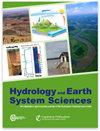Technical note: Testing the effect of different pumping rates on pore-water sampling for ions, stable isotopes, and gas concentrations in the hyporheic zone
IF 5.8
1区 地球科学
Q1 GEOSCIENCES, MULTIDISCIPLINARY
引用次数: 0
Abstract
Abstract. The hyporheic zone (HZ) is of major importance for carbon and nutrient cycling as well as for the ecological health of stream ecosystems, but it is also a hot spot of greenhouse gas production. Biogeochemical observations in this ecotone are complicated by a very high spatial heterogeneity and temporal dynamics. It is especially difficult to monitor changes in gas concentrations over time because this requires pore-water extraction, which may negatively affect the quality of gas analyses through gas losses or other sampling artifacts. In this field study, we wanted to test the effect of different pumping rates on gas measurements and installed Rhizon samplers for repeated pore-water extraction in the HZ of a small stream. Pore-water sampling at different pumping rates was combined with an optical sensor unit for in situ measurements of dissolved oxygen and a depth-resolved temperature monitoring system. While Rhizon samplers were found to be highly suitable for pore-water sampling of dissolved solutes, measured gas concentrations, here CH4, showed a strong dependency of the pumping rate during sample extraction, and an isotopic shift in gas samples became evident. This was presumably caused by a different behavior of water and gas phase in the pore space. The manufactured oxygen sensor could locate the oxic–anoxic interface with very high precision. This is ecologically important and allows us to distinguish between aerobic and anaerobic processes. Temperature data could not only be used to estimate vertical hyporheic exchange but also depicted sedimentation and erosion processes. Overall, the combined approach was found to be a promising and effective tool to acquire time-resolved data for the quantification of biogeochemical processes in the HZ with high spatial resolution.技术说明:测试不同泵送速率对孔隙水采样的影响,以获取离子、稳定同位素和低渗区气体浓度
摘要潜流带(HZ)对河流生态系统的碳和养分循环以及生态健康具有重要意义,但也是温室气体产生的热点。该交错带的生物地球化学观测具有高度的空间异质性和时间动态性。监测气体浓度随时间的变化尤其困难,因为这需要孔隙水提取,这可能会通过气体损失或其他采样伪影对气体分析质量产生负面影响。在这次实地研究中,我们想测试不同泵送速率对气体测量的影响,并安装了Rhizon采样器,在一条小溪的HZ中重复提取孔隙水。不同泵送速率下的孔隙水采样与用于溶解氧原位测量的光学传感器单元和深度分辨温度监测系统相结合。虽然发现Rhizon采样器非常适合于孔隙水中溶解溶质的采样,但测量的气体浓度(这里是CH4)在样品提取过程中表现出强烈的泵送速率依赖性,并且气体样品中的同位素变化变得明显。这可能是由于水和气相在孔隙空间中的不同行为造成的。所制备的氧传感器能够以很高的精度定位氧-缺氧界面。这在生态学上很重要,并使我们能够区分好氧和厌氧过程。温度数据不仅可以用来估计垂向地下交换,而且可以描述沉积和侵蚀过程。综上所述,该方法是一种获得时间分辨率数据的有效工具,可用于高空间分辨率的HZ生物地球化学过程的量化。
本文章由计算机程序翻译,如有差异,请以英文原文为准。
求助全文
约1分钟内获得全文
求助全文
来源期刊

Hydrology and Earth System Sciences
地学-地球科学综合
CiteScore
10.10
自引率
7.90%
发文量
273
审稿时长
15 months
期刊介绍:
Hydrology and Earth System Sciences (HESS) is a not-for-profit international two-stage open-access journal for the publication of original research in hydrology. HESS encourages and supports fundamental and applied research that advances the understanding of hydrological systems, their role in providing water for ecosystems and society, and the role of the water cycle in the functioning of the Earth system. A multi-disciplinary approach is encouraged that broadens the hydrological perspective and the advancement of hydrological science through integration with other cognate sciences and cross-fertilization across disciplinary boundaries.
 求助内容:
求助内容: 应助结果提醒方式:
应助结果提醒方式:


